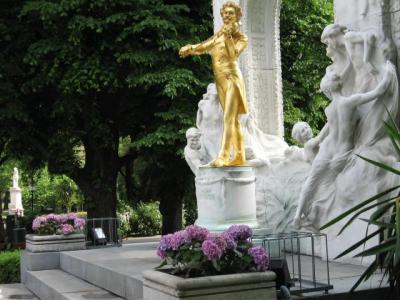Some books you skim and read quickly, others you try to absorb in their entirety. For me Johann Strauss: Father and Son. A Century of Light Music (Greystone Press, 1939) falls into the latter category. Author H.E. Jacob and translator Marguerite Wolff paint a multi-coloured picture about 19th century Europe, where the waltz and Strauss compositions captivated the public.
This work is interesting on several levels: as a father and son family biography, positioned against a backdrop of world events; and showing the musical evolution of that era using specific musical notations of many compositions. This last feature can be only appreciated by true musicians which many readers may be, but which this reviewer is not.
This musical and historic journey begins in pre-revolutionary France, where the aristocratic, aloof minuet held sway. In this era, in some jurisdictions, if a girl was ‘spun or turned’ in a dance, the partners could be subject to heavy police fines. With the fall of the Bastille, the minuet gave way towards more egalitarian dances such as the round dance and ländler which led to the waltz. (Mozart in Don Giovanni Act II, is the only composer to have combined the aristocratic minuet with the simple village waltz.) Jacob highlights that revolution took place in Paris where there was a more stringent class differentiation than in Vienna, where there was food aplenty, the classes mingled more at social dancing events, and hardships from previous epidemics and invasions were still in people’s memories.
At the Vienna Congress which settled post-Napoleonic Europe’s direction for the next century, the waltz was the dance of choice for the thousands attending. Its popularity grew even more widely after the Congress when dignitaries took the dance back to their native lands. This was the world of Johann Sr’s youth, where he would join his slightly older friend’s Josef Lanner’s orchestra which gained wide renown throughout Vienna. Lanner’s compositions started to take the waltz to a more sophisticated level, and Strauss also had to start composing to keep up with the nightly waltzing public’s demand.
After an altercation with Lanner, Johann at twenty-one started his own orchestra and expanded his composition of waltzes. At this time he also had to get married, as he had impregnated his landlord’s daughter Anna Streim. This led to the birth of Johann Jr, later also to two brothers (Joseph and Eduard) and two sisters. All of the sons would become active in the music business even though father was not keen with this direction.
The book provides many highlights from the lives of the Strausses. One such incident occurred when Johann Sr and Lanner after a night of carousing tied a sleeping coachman’s horses to a tobacco store’s plaster Turkish smoker statue. The two then proceeded to wake the coachman and have him whip the horses, which initially resisted, but then took off with a great racket, breaking up the statue and several windows on their journey down the streets of Vienna.
Johann Sr was opposed to his sons following musical careers, although he was aware that mother Anna had put the boys into piano lessons. He was, however, unaware of Johann Jr’s violin lessons from his own orchestra’s violinist Amon. Johann Jr was so accomplished by the age of fifteen that he was able to pay for his lessons by earning money providing music lessons of his own.
In spite of the large number of waltzes that he composed, it is ironic that Johann Sr’s best known composition is the Radetzky March, which celebrated the 1848 victories of the Habsburg General Radetzky. This music was well received by the old guard of Vienna, but it was not popular with the young republicans, a group to which his sons belonged.
At the age of nineteen, Johann Jr introduced his orchestra to Vienna to earn support for his now divorced mother. Thus Vienna had two orchestras led by Johann Strauss. Writers at the time remarked that the younger Strauss, the burgeoning Waltz King, was far ahead of his father in musical composition at the same age. Johann Sr had taken his popular waltzes throughout Europe, and Johann Jr would expand the popularity of the waltz by taking his music even further to St. Petersburg and North America. In fact, Johann Jr was in such demand in the United States that ladies demanded genuine locks of his black curly hair. Unfortunately, his black Newfoundland dog had to sacrifice its coat to meet this demand.
Johann Jr was a prolific composer and his Blue Danube waltz and Die Fledermaus operetta are debatably the greatest music of their genre. Great ‘serious’ composers like Gustav Mahler and Johannes Brahms recognized and appreciated the genius of the younger Strauss. What was interesting to read about the Blue Danube Waltz was first the Danube is never blue, and second it was written as a song for a male chorus, but its initial Vienna reception was tepid. However, when it was played in Paris a few months later with no choral accompaniment, it immediately became an overnight sensation.
This book is extremely informative and very well written. Besides covering the lives and compositions of Johann Sr and Jr, Jacob provides many additional insights such as describing the important influences musicians Johann Nepomuk Hummel and Jacques Offenbach had in the development of Strauss compositions. Jacob’s ability to continually provide little known, but fascinating information to the reader, makes this book a must read for classical, light music aficionados. The book is available from Kessinger Publishing Rare Reprint, www.kessinger.net or at amazon.ca.

A musical journey with the composers Johann Strauss
Archived Articles | 19 Jun 2009 | T. TreiEesti Elu
Archived Articles
TRENDING



















